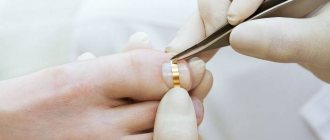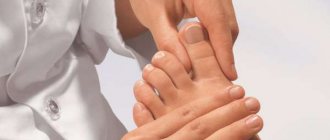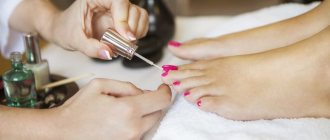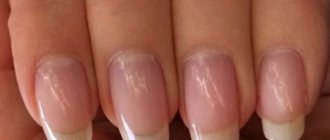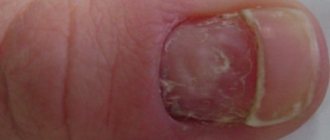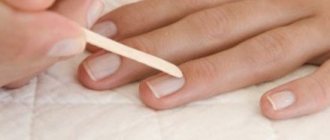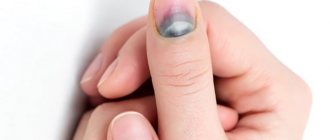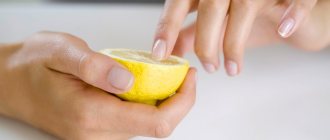Reasons for removing the nail plate
Removal of the nail plate is required only in extreme cases, when it is not possible to correct the situation with more gentle methods. The main reasons for nail removal:
- Ingrown nails into the nail fold as a result of improper surgical intervention, improper manicure, or congenital characteristics.
- Removing fungus from the nail plate.
- Nail injuries of various types.
- Oncopathology involving the nail bed. For example, squamous cell carcinoma, melanoma.
The main reason for nail removal is the fungus, which spreads throughout the body quite quickly. You can tell that a nail is infected with fungal bacteria by a change in color to a pale gray, separation of the nail from the nail bed, and a change in its structure. With fungus, nails become very fragile, break quickly and often peel. Often the nail goes in “waves” and various irregularities appear on it.
Treatment of fungus by removing the nail is required when more than 50% of the area is affected. In other cases, you can get by with special treatment using ointments and other medications. Without removing the affected area, with a probability of up to 90%, after some time the disease will return with renewed vigor.
For fungus
The scientific name of the fungus is onychomycosis. A fairly common disease of the nail plate, which causes a lot of inconvenience. Removal of the nail due to fungus is required when the affected area is more than 50%.
Ointment for removing fungal nails may not always be effective because fungal bacteria are located directly on the nail bed. The development of the disease not only causes discomfort to a person, but also spoils the appearance of his nails: the nail plate becomes fragile, often peels off, and is often deformed and covered with “waves.”
For minor lesions of the nail plate, you can get by with ointments or a special plaster, but in particularly serious cases, you cannot do without removing the nail.
For ingrown toenails
The nail can be ingrown from birth, or change its shape as a result of injury or mechanical stress. An ingrown toenail causes a lot of inconvenience: it is almost impossible to step on the injured leg, and you cannot use your hands without pain.
You can understand that a nail is growing into the skin by the following signs:
- Painful movements.
- The appearance of redness in the nail area.
- The damaged area swells.
If you notice the problem in time, you can get away with having the excess part of the nail removed by a specialist. If the disease starts, you will need to remove the entire nail plate, since an ingrown nail is often the cause of the development of fungal and other diseases. The fungus takes root best when it enters directly through wounds, which are inevitable with ingrown nails.
Surgery is a short-term procedure, lasting no more than 30 minutes. The specialist administers local anesthesia, removes the injured nail or part of it and bandages the finger. Sometimes additional medical examinations are prescribed by a doctor, as it is necessary to monitor the healing process.
Typically, removal of an ingrown toenail occurs surgically. This measure is necessary to prevent the possibility of repeated ingrowth of the nail into the skin, since it directly depends on the characteristics of the nail fold and nail bed. Particular attention should be paid to treatment after removal of an ingrown toenail, since all kinds of infections can get into open wounds.
In case of injury
When injured, the nail often becomes deformed and changes its appearance. In addition, it can split or move away from the nail fold, causing pain and inconvenience. As a result of deformation of the nail plate, pathogenic bacteria can enter the wound, causing infection, suppuration, and redness of the nail.
In case of injury, not the entire nail plate is often removed, but only the affected area. Measures to eliminate inflammation will help maintain the health of the entire nail and prevent serious infection.
Will a new nail grow after removal?
Nail fungus destroys the nail plates. They thicken, become deformed, and their color changes. The disease can be cured in two ways - using fungicidal agents or by removing the nail.
If the disease is treated with conservative methods, it will take about 9 months for the nail to recover from fungus. In this case, the peculiarities of caring for the nail plates play an important role. They need to be steamed every day, cleaned of destroyed particles and the chosen medicine applied.
As they grow, the nails are trimmed. Each regrown area is a small victory over the fungus. Treatment is stopped only after the nail plate is completely renewed.
It is recommended to use anti-fungal ointments and varnishes for another two months after the nail grows back for prevention.
If all actions are carried out according to the doctor’s recommendation, there will be no problems with nail regrowth and restoration.
Stages of nail regrowth after fungus
In some cases, the recovery time may be increased. This is due to the characteristics of nail growth. If a person’s nails have always been weak and grew slowly, it may take about a year for the nail plates to fully recover when treated with medications.
Fingernails are restored on average in 4-6 months. Toenails are completely renewed in about 9 months.
Removing the nail will help you quickly get rid of onychomycosis. This can be done in two ways - in the doctor's office or at home. In the first case, the risk of impaired nail growth is minimal. The doctor carefully removes the nail and applies a loose bandage, having previously treated the surface of the nail bed with an antiseptic or antibiotic.
This bandage must be worn for about 10 days and then removed. It is important to protect the soft nail bed from accidental damage to ensure that the nail grows smooth and healthy. It usually takes several months for the nail plate to recover. It grows slowly, at first it is soft and fragile, which requires careful handling.
If nails do not grow after an advanced fungus, the cause must be sought in treatment methods. There are kits that allow you to remove the affected nail at home.
Such products contain special urea patches, which soften the nail and promote its removal from the nail bed.
If such products are used incorrectly, the growth of the nail plates or their deformation may occur.
We suggest you familiarize yourself with Blackheads between the toes
The most unfavorable outcome is the independent detachment of the nail destroyed by the fungus. In this case, the nail moves away from the nail bed, but pathogenic microflora continues to develop on the finger. As a result, the nail will not grow unless the fungus is destroyed, since the nails do not have time to grow, literally being eaten by the fungal spores that remain on the skin.
Restoring nails after toenail fungus is a long process, especially if the nail plates were surgically removed. In this case, you should not use any external auxiliary products without consulting a doctor. After removal, the doctor applies a bandage and gives recommendations on nail care.
Until the nail recovers, contact with household chemicals, cosmetics and hot water should be avoided. Any housework should be carried out only with gloves.
During therapy to restore the nail after treating fungus, you can take vitamins. Pharmacies offer special vitamin complexes for beauty that contain substances that accelerate the growth of hair and nails.
Another common problem is deformation of the growing nail. This happens in two cases: improper care after removal of the nail plate or nail injury.
Unfortunately, it is not possible to quickly fix an already deformed nail. You just need to wait for it to grow back, regularly using vitamin preparations for nails and filing them.
Deformation may also be due to re-infection with a fungus. If in this case the nail does not grow, only a doctor can tell you what to do and how to finally get rid of the fungus. The deformed nail can be removed again, or wait until it is completely restored.
How to speed up the nail restoration process?
The first thing that needs to be done is to completely destroy the pathogenic microflora. Restoring a nail after a fungus is impossible until the infection is completely destroyed, but if the spores remain on the skin, complete rehabilitation may take years.
To make sure there is no fungus, you should consult your doctor. The doctor will conduct a series of tests for the presence of pathogenic microflora. If spores still remain, it is necessary to continue using fungicidal agents. Nail restoration can be started only if the analysis does not reveal pathogenic microflora.
Before you restore your nails, you need to make sure that onychomycosis is defeated
Pharmacy drugs
How toenails grow after a fungus depends only on whether the infection was completely defeated. If there are no visible symptoms of onychomycosis, but fungal spores are found in the scraping, it is necessary to continue treatment with fungicidal agents. For this use:
- Exoderil;
- Loceryl;
- Lamisil;
- Miconazole;
- Terbinafine.
The selected product must be applied to the nail plates and periungual ridges twice a day. This therapy continues until the analysis shows the absence of pathogenic microflora.
Additionally, you can use varnishes to protect the nail plates and fight fungus. For this purpose, Loceryl or Batrafen are prescribed. Your doctor will tell you more about effective medications.
After the complete destruction of pathogenic microflora, care must be taken to create conditions favorable for nail restoration. For this purpose, medicinal varnishes with vitamins and nourishing oils are used.
The best remedies to use if the nail stops growing after a fungus:
- sea buckthorn oil;
- tocopheryl acetate;
- vitamin A;
- almond oil;
- cosmetic clay.
All these products can be purchased at the pharmacy. Sea buckthorn oil contains a complex of vitamins and promotes regeneration. You can apply it even after removing the nail, but only a month after the residual wound has healed. Apply the product with a cotton swab daily before bedtime. Sea buckthorn oil must be used for a month.
Sea buckthorn oil is known for its regenerating properties
Tocopherol acetate or vitamin E is sold in every pharmacy. To treat nails, you need to purchase an oil solution of this vitamin. The product should be applied to the nails and rubbed in with gentle massage movements. The procedure must be carried out regularly.
Vitamin A can be mixed with vitamin E or applied alone. This drug is also sold in pharmacies in the form of an oil solution.
We invite you to familiarize yourself with DNA after the death of your father - Citizens' Rights
Almond oil is nutritious and contains many beneficial substances. It must be applied to the nails so that they grow strong and even.
Masks are made from cosmetic clay. It should be mixed with warm water until a thick consistency is obtained and applied to each nail for 10 minutes. Additionally, the nail can be covered with cling film. This clay contains a large amount of minerals that help strengthen the nail plates.
Folk remedies
If the nail stops growing after the fungus, you can turn to traditional medicine. To accelerate the growth of nail plates, you should use baths and lotions.
- Lemon will help improve the condition of your nails. Its juice should be mixed in equal proportions with water and applied to the damaged nail. The procedure should be repeated daily.
- Another effective folk method of recovery is compresses with calendula. To do this, brew a tablespoon of calendula flowers with a glass of boiling water and leave for 30 minutes under the lid. Then soak a cotton pad in the product and press it onto the sore nail for 5 minutes.
- A homemade peach pulp mask will help restore your nails. To do this, you need to mash the pulp with a spoon and apply it to the nail for 10 minutes, securing it with a bandage. You can also use a banana.
- Cabbage leaves will help whiten your nails and make them healthier. To do this, mash a large cabbage leaf until the juice comes out and apply it to the nail for 20 minutes.
Lemon strengthens and whitens nails
Having figured out how long a toenail grows after a limb fungus and how important it is to prevent injuries to the nail bed, you should pay attention to lifestyle and nutrition. To speed up the recovery process, you need to introduce the following products into your diet:
- milk and kefir;
- fish;
- vegetables;
- berries;
- whole wheat bread.
These products contain substances necessary for normal nail growth and therefore speed up the recovery process.
During rehabilitation after a cured fungus, you need to prevent injuries to the diseased nail. The nail plate should be protected from accidental damage in everyday life, as well as from high and low temperatures. You should avoid using nail polish while recovering from onychomycosis.
If, despite all the measures taken, after treating nail fungus, the nail still does not grow, you should consult a doctor.
Source: https://murow.ru/vyrastet-novyy-nogot-posle-udaleniya/
Methods for removing the nail plate
In cases where it is not possible to cure the nail plate, they resort to its removal. There are several main ways to remove a nail:
- Surgical intervention. Required in extreme cases when other methods are less effective. The operation to remove an ingrown or injured nail is quite painful, but with the help of modern medications, specialists manage to reduce discomfort to a minimum.
- Medication methods.
- Applying a nail removal patch.
- Hardware manicure.
- Radio wave method.
- Laser therapy. A painless and fairly quick way to remove a nail plate.
- Chemical method. The nail is removed under the influence of chemicals that destroy its structure.
Surgical nail removal
Surgical removal of part of an ingrown toenail has long ceased to be the only way to solve the problem. Experts recommend resorting to this option when the condition of the nail is neglected. The operation is performed under local anesthesia, but the patient may feel pain for some time after the nail is removed.
The nail is separated from the nail bed using a scalpel, after which the wound is carefully treated with an antibiotic to protect the nail from infectious and fungal bacteria. The method is contraindicated in patients with a low rate of regeneration of damaged tissue, as well as poor blood clotting.
Hardware pedicure
Hardware pedicure is performed by a medical pedicurist. For this purpose, special equipment is used, and before the procedure begins, the finger is placed in a special solution to soften the tissue.
Hardware pedicure is used to remove part of an ingrown or injured nail. Special staples are used to straighten the nail plate. The procedure is quite painful, but under the guidance of an experienced specialist, discomfort is minimized.
Laser therapy
Laser therapy is a method that is actively used at present and allows one to avoid surgical intervention. Pain is eliminated in just one session, as laser therapy is quite effective. To prevent the patient from feeling discomfort and pain, the procedure is performed under local anesthetic.
Laser nail therapy takes about twenty minutes. The main advantages of this procedure include:
- No pain.
- The process is quite fast and efficient.
- Absence of any relapses and bleeding.
- Quick rehabilitation of the nail plate.
- Aesthetics.
With laser therapy, only the damaged area of the nail is removed, the healthy part remains untouched. However, the procedure is contraindicated in patients with poor blood clotting, as well as in the presence of diabetes mellitus and other blood and vascular diseases.
Chemical method
It consists of using various chemicals that soften the nail, after which it is easily and painlessly removed. The procedure consists of the following steps:
- Cleaning the nail plate.
- Gluing a special tape around the nail to protect the delicate skin from possible damage.
- Applying a chemical solution to remove nail fungus.
- The ointment is secured on top with a bandage.
It takes 3-4 days to wear this bandage, after which the nail will be removed easily and painlessly.
Radio wave
The procedure involves minimal pain and is also performed under local anesthesia. The affected areas of the plate are treated using radio waves, then covered with a sterile bandage to avoid complications after nail removal.
The discomfort disappears the next day, and the patient can return to normal life.
Nail restoration after fungus: why nails don’t grow after treatment and what to do
Dermatologist of the highest category Inna Vladimirovna
32279
Update date: April 2020
Every patient who has managed to cope with onychomycosis requires nail restoration after fungus. This event is necessary to maintain the therapeutic course. In addition, procedures aimed at restoration help to quickly grow healthy nail plates even after their complete removal.
Features of nail regrowth after fungus
Many people who have treated fingernail or toenail fungus have encountered problems associated with the slow regrowth of healthy nails. This phenomenon is usually associated with severe damage to the epithelium that is found in the nail bed. If onychomycosis occurs in an advanced form, then scar tissue forms in this place in the patient, which does not allow the plates to fully grow.
All rehabilitation procedures must be carried out under the supervision of a specialist. This will allow a person to avoid re-infection or further damage to the nails. But even if this requirement is met, patients do not always achieve the desired goal. This is because a number of factors influence nail growth and the quality of its restoration:
- Age and gender of the person. It is believed that nails grow best in teenage children and pregnant women. For other people, nail plates grow no more than 4 mm per month;
- Season. In the warm season, nail growth is rapid. During cold periods it slows down significantly;
- General condition of the body, including hormonal levels. Nails grow best in people with a strong immune system.
For the rehabilitation period to be successful, it is necessary to provide your nails with complete care. It is necessary to carry out various procedures that improve this process, as well as to avoid the influence of unfavorable factors on the plates that slow down their growth.
If the fungus is severe, the nail must be removed completely.
Recovery methods
If the fungal infection has been defeated, and the patient seems that the nail has stopped growing, then he should think about taking restorative measures. To monitor the dynamics of recovery, it is advisable to find out in advance how long a toenail or fingernail grows. This information will be needed to compare the norm and the current result.
How to grow a nail back after removal
Doctors often have to listen to complaints that nail fungus has been defeated, but the nail plate still does not grow. Typically, this problem is encountered by those patients who, due to the advanced state of the disease, had to completely remove the affected areas.
After complete removal, a new nail grows on average in 3-6 months. The speed of this process depends on a number of factors, namely the patient’s age, gender, time of year and state of health.
Relaxing in a resort area with a favorable climate helps to heal your nails faster. It is also worth taking care in advance to strengthen the immune system. Periodically it will be necessary to prevent relapse of onychomycosis.
General Tips
It's no secret that there are different stages of nail restoration after fungus treatment. A person can speed up each of the stages if he avoids the influence of unfavorable factors on the plates. For rehabilitation to be quick and successful, the patient needs to follow a few simple rules and recommendations:
- You need to watch your daily diet. He must be full and healthy. Nails will begin to grow faster if valuable microelements and vitamins enter the body. It is recommended to include in the menu foods that are enriched with vitamin C. These are gooseberries, tomatoes, citrus fruits, and bell peppers. You also need to pay attention to foods with vitamins A and B. These include carrots, eggs, liver and butter. Greens are no less useful. Such nutrition allows you to accelerate the regenerative function and increase blood circulation to increase the saturation of tissues with valuable substances. Dairy products, buckwheat, apples and bananas will help prevent brittle nails;
- It is strongly recommended to protect nails from the negative effects of aggressive substances. Women and men who have recovered from onychomycosis are prohibited from contacting cleaning agents and detergents. Thick gloves help protect your hands from them;
- It is necessary to remember to regularly moisturize the nail plates and the skin around them. Natural oils based on grapes, olives or peach help to cope with this simple task;
- It is worth purchasing for yourself a medicinal varnish that nourishes and protects the nail from aggressive environmental influences. Some varieties of this remedy additionally stimulate the growth of plates;
- Don’t forget to regularly do various baths and applications for nails, which have a positive effect on their growth and general condition. Among the mandatory procedures, it would not hurt to include paraffin compresses, to which a couple of drops of tea tree oil are added. No less useful are baths made from a decoction of chamomile, burdock, sea salt and iodine.
Restoring nail plates, as well as treating them for fungal infections, takes a lot of time. If a person intends to make his nails healthy and beautiful, he will have to regularly carry out procedures that trigger the regeneration process in places where they are severely damaged. Additionally, he must take care of the health of the entire body, and especially the state of the immune system.
Source: https://DermatologInfo.ru/gribok/lechenie-gribka/metody-vosstanovleniya-nogtya-posle-gribka/
How to remove a nail yourself
Self-removal of the nail should be resorted to only in extreme cases. For example, when it is not possible to seek help from a specialist. Swelling or inflammation that may appear near the affected nail can be removed with a bath of furatsilin. You can reduce severe pain from ingrown toenails using lotions based on fir oil.
Traditional recipes cannot completely remove the nail plate - this requires the help of a professional. With the help of baths or lotions, you can get rid of painful sensations and avoid inflammation. They will also help get rid of swelling of the finger after removing the nail plate.
Types of operations
Today, any medical clinic offers the following methods for eliminating pathology:
- surgical treatment using a scalpel (removal of an ingrown nail, completely or partially);
- laser correction;
- plastic surgery of the periungual fold;
- operation using radio waves.
Surgical method
An ingrown toenail can be corrected surgically using a scalpel. The operation is performed only after confirmation of the effect of anesthesia and lasts no more than 30 minutes.
If the nail begins to grow in, forming areas of pus, the doctor may apply a tamponade. In other words, a special soft material is placed under the nail plate, which is impregnated with an antiseptic. Once the pus has been eliminated, surgery is performed to remove the ingrown toenail:
- Performing marginal resection - removing part of the nail at an angle of 45 degrees. Not the most reliable way to eliminate pathology, since it often returns again.
- Carrying out selective resection with removal of part of the matrix. According to statistics, relapse of the disease occurs only in 2% of cases.
- Performing a complete nail removal is a quick and easy method of getting rid of an ingrown toenail, but re-ingrown toenails can still happen.
- Carrying out phenolization of the nail plate, that is, complete removal of the nail. He will no longer be able to grow back. This operation is rarely prescribed.
Laser treatment
Laser treatment of the nail is an excellent method for permanently removing ingrown toenails. The advantages of this treatment are:
- lifelong relief from the problem. According to statistics, only 1% of cases of such treatment are accompanied by relapse;
- adjacent areas are damaged extremely rarely. During laser surgery, only the affected tissue is removed. The growth areas of the nail remain unchanged;
- short recovery period. In this case, we can say that healing does not take long, while pain and discomfort are almost not observed;
- complications occur extremely rarely. It should be noted that there is no possible bleeding or infection;
- Laser treatment is also safe for children.
Plastic surgery of the periungual fold
In other words, Schmieden's operation. This treatment is quite painful, so it is carried out using anesthesia, which is injected on both sides of the damaged nail.
Before the operation, a tourniquet is applied to the base of the finger, which will help prevent bleeding during the intervention.
The next step is to cut the nail with small scissors. Using scissors, the soft tissues are cut, and then the hypergranulation is excised. Next, a fragment of the nail matrix is excised.
The final stage is the sutures that are placed on the wound. You can also simply cover the wound with a bandage. It heals completely in a week. To avoid negative consequences, it is recommended to change the bandage every day.
Radio wave treatment
This type of treatment is characterized by the removal of only the ingrown lateral edges. In this case, injury to nearby soft tissues does not occur. After such an operation, re-ingrowing of the nail does not occur.
The advantages of radio wave treatment are that the operation will take no more than 15 minutes, the possibility of treatment at any stage of the disease, the painlessness of the treatment is determined by local anesthesia. It is also worth considering that stitches are not required. After the operation, it is enough to apply a bandage, which can be changed at home.
Features of the postoperative period
Particular attention should be paid to how the nail grows after removal. If the procedure was carried out correctly, the new nail plate will be smooth, although a little thin at first. Care after nail removal should be carried out with special care - it is important to follow all the recommendations of the attending physician.
Relief of hand pain
Hands must be clean at all times and the bandage must be dry. A few simple rules of care:
- Apply a special ointment to the nail after removal.
- When in contact with water, wear waterproof gloves.
- Regularly treat your hands with antiseptic.
- Avoid physical work with dirt.
New finger injuries should not be allowed.
How to relieve leg pain
You can relieve leg pain in the following ways:
- Wear clean cotton socks.
- Avoid tight shoes and give your feet rest.
- When walking, try not to put your body weight on the sore toe.
- Apply a clean gauze bandage to the damaged area.
- Avoid physical activity for the first two weeks.
If swelling appears, contact a specialist immediately.
Recommendations for caring for the nail plate
Caring for the removed nail is an important point in recovery. At the site of the removed plate, a wound surface of the nail bed is formed, which must be carefully cared for. After removal, you need to apply a disinfectant and antifungal ointment to the plate. Next, you need to make a sterile gauze dressing, which needs to be changed daily.
Some tips for treating the wound after removal:
- Bandaging your finger after removing the nail will help relieve pain. It is based on the mother with an analgesic effect. The dressing should always be dry and clean.
- Ibuprofen and Acetaminophen will also help get rid of pain, but you should take them only after consulting a specialist.
- To prevent dirt from getting inside the wound, before any activity you need to thoroughly wash your hands with soap and regularly steam your feet in a medicinal solution.
- If discomfort and swelling occur, you should consult a doctor.
The basic rules of care after toenail removal include taking other precautions:
- the gauze bandage should be kept dry;
- You should try to walk so as not to transfer your body weight onto the operated finger;
- You need to wear clean cotton socks and try to avoid tight and uncomfortable shoes;
- it is necessary to avoid excessive load on the leg (running, jumping, fast walking, etc.).
To prevent infection of the nail bed after nail removal, you can take antibiotics internally, as well as externally in the form of ointments.
When changing dressings and applying medications, hands should be clean. Attention! If, after removing a nail, you feel severe pain and significant swelling appears on the nail bed, then you should immediately show your finger to a specialist.
In some cases, your doctor may prescribe a medicine with antibiotics if the pain is too much to bear. These simple recommendations will help you grow your new nail healthy and beautiful.
What to do after removing an ingrown toenail to avoid recurrences
Ingrown toenails are still one of the most common nail problems. People do not notice this disease until swelling and terrible pain appear. And after treatment you need to avoid relapses.
Before answering the question of what procedures doctors recommend to carry out in order to avoid possible re-ingrowing nails, you should understand what leads to this problem. Ingrown toenails are medically called onychocryptosis. As a rule, the nail plate grows laterally into the nail fold. The process occurs gradually, however, penetrating into the soft tissues of the finger, the nail causes redness and inflammation. In the first stages, the disease does not cause discomfort and the presence of a problem can only be determined through a thorough examination. Over time, pain appears in the ingrowth area, which occurs while walking. And in the later stages, the pain does not stop even during moments of rest, and pus begins to ooze from the wound that forms at the site of the ingrown nail. If treatment is not started on time, the tissues surrounding the problem area will begin to die, which can even lead to gangrene.
Important addition: Psoricontrol for psoriasis
Knowing how the nail grows, you can easily diagnose this condition at an early stage, subject to a thorough examination of the fingers and the condition of the nail plates. On the one hand, in a developed society it is customary to take care of your feet, so why is the number of visits to medical institutions not decreasing? The answer is simple: it's all about the wrong pedicure. Of course, it cannot be denied that genetic predisposition contributes to ingrown nails, but in most cases this problem is provoked by finger injuries, as well as improper pedicure. In addition, recently the number of people suffering from excess weight has increased, and doctors classify this category of the population as a risk group, because overweight people have especially strong pressure on their feet. Another reason for the development of toe deformities are fungi and infections.
Ingrown nails detected in the early stages can be cured without the use of drastic surgical measures. As a rule, in such cases, doctors recommend using hot baths with certain drugs added to the water. In addition, while the tissues of the damaged fingers are steamed, it is possible to gradually remove the ingrown part of the nail and remove it. Of course, this will take more than one day, but in this case neither the soft tissues of the periungual fold nor the nail plate itself will be deformed.
Unfortunately, much more often an ingrown toenail makes itself felt in the later stages, attracting attention with pain. And late diagnosis does not make it possible to carry out treatment with gentle methods
In such cases, patients are recommended to undergo surgery. Until recently, if a nail had grown into the skin, it was removed using standard surgical procedures, during which the soft tissue of the finger was incised and the ingrown part of the nail was cut out and removed. Despite the fact that this procedure is performed under anesthesia, it cannot be called painless, since healing is a long process. Recently, operations have been performed using lasers.
Prevention of ingrown nails is a prerequisite for everyone who is faced with this disease, regardless of at what stage it was detected and what treatment measures were taken. First, you need to make sure that the edges of the nail plate are not cut too short and do not dig into the skin. A proper pedicure involves giving your nails a somewhat square shape. At the same time, the corners of the nail plate should not be too rounded. Ideally, they should be 1-2 mm longer than the nail bed.
Secondly, experts point out that to prevent recurrences of ingrown toenails, you should choose shoes that will not put pressure on your feet. When trying on shoes after removing an ingrown toenail, you should check whether you can move your toes inside the shoe
True, shoes should not be too spacious, otherwise the formation of corns and calluses may occur. Also, you should not always give preference to shoes without heels. In fact, the best models are those with 4-5 cm heels for women and 2 cm heels for men. But high heels and unstable models significantly increase the load on the toes of the feet, leading to severe deformation of the toes.
Treatment of ingrown toenails is a very unpleasant process, so preventing the occurrence of such a problem is highly desirable. Moreover, relapses are possible even after a well-performed operation.
Possibility of nail prosthetics
Prosthetics allows you to build up your nails, make them smooth and beautiful in a short time. the procedure is carried out using a special gel, which is applied from a tube to the cleaned surface of the nail.
Prosthetics of the nail plate can be used for fungus, as well as injury to the nail. A special tool allows you to accurately recreate the nail and make the prosthesis as natural as possible.
Prosthetic repair of toenails is more difficult than that of fingers. In particular, this is due to limitations when choosing a tool and the structure of the nail plate.


